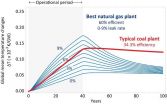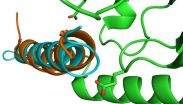(Press-News.org) DURHAM, N.C. -- By identifying the most efficient fishing practices and behaviors, a new model developed by economists at Duke University and the University of Connecticut could help fishermen land larger paychecks while reducing the risk of fishery depletion.
"We're not talking about a trivial improvement. In some cases, we found that identifying the most efficient practices led to a 20 percent annual increase in total revenues if the fishery is managed differently," said Martin D. Smith, professor of environmental economics at Duke's Nicholas School of the Environment.
"Under perfect conditions, you could see up to a 49 percent increase in profits on average," he said.
The empirical bioeconomic model developed by Smith and Ling Huang, assistant professor of economics at the University of Connecticut, is the first of its kind. It was created using six years of previously unavailable fine-scale fishing data from the North Carolina shrimp fishery, provided to the researchers by the North Carolina Division of Marine Fisheries.
"Every single vessel that went out was tracked -- what it caught, when it fished, what price it sold its catch for, and what equipment was used," Smith said. "We also tracked daily weather conditions, fuel prices, fishery closures and other external factors that affect fishermen's decisions of whether to fish or not."
Smith and Huang analyzed the flood of data using recently developed econometric modeling techniques to identify which individual fishing practices and decisions led to profitable and sustainable catches, and which led to low returns and overexploitation.
The results yielded some surprises.
"Conventional wisdom says that congestion -- having too many boats out at the same time -- is bad because it makes it harder for individual fishermen to catch at the level they're used to, so profits drop," Smith said. "We found this is true in the short run, but there's a potential long-term benefit fishery managers may be overlooking.
"When people's profits drop due to congestion, they tend to fish less. This means more of the shrimp left in the water get to grow to larger sizes and can be harvested later in the season for higher prices," he said. "So in some cases, congestion can actually increase potential late-season profits and reduce the risk of fishery depletion."
Smith and Huang's study focused primarily on the open-access N.C. shrimp fishery, but insights from it could help improve how other fisheries are managed as well.
"We're leaving substantial profits on the table due to the way we're managing many fisheries," Smith said. "The standard one-size-fits-all management approach of allocating sustainable catch limits to individual fishermen on an annual basis is not universally efficient. In some cases, it's actually counterproductive because it forces fishermen into a 'race to fish' early in the season that leads to falling profits, overexploitation and, eventually, tragedy of the commons."
The key to avoiding this, Huang said, is to match the management approach of each individual fishery to the daily, fine-scale dynamics of its fishermen, its seasonal patterns, and the life history of the species being harvested.
"Our analysis shows there's a sweet spot between having too much bureaucracy -- such as daily quotas -- and too little. That's the spot we have to hit if we want to maximize profits and sustainable catches," she said. "To get there, you have to dig down to the fine scale."
INFORMATION:
Smith and Huang published their study in this month's issue of the peer-reviewed journal American Economic Review. Funding came from the NOAA Center for Sponsored Ocean Research (grant # NA05NOS4781197). Huang is a former student of Smith's. She earned her Ph.D. in environmental economics from Duke in 2009.
CITATION: "The Dynamic Efficiency Costs of Common-Pool Resource Exploitation," by Ling Huang and Martin D. Smith. American Economic Review, Dec. 3, 2014. http://dx.doi.org/10.1257/aer.104.12.4071.
The same research team that developed the first laser based on a living cell has shown that use of fluorescent proteins in a solid form rather than in solution greatly increases the intensity of light produced, an accomplishment that takes advantage of natural protein structures surrounding the light-emitting portions of the protein molecules. The findings from investigators Seok Hyun Yun, PhD, of the Wellman Center for Photomedicine at Massachusetts General Hospital and Malte Gather, PhD, of the University of St. Andrews in the U.K. appear in the online journal Nature ...
CHARLOTTESVILLE, Va. -- The majority of streams in the Chesapeake Bay region are warming, and that increase appears to be driven largely by rising air temperatures. These findings are based on new U.S. Geological Survey research published in the journal Climatic Change.
Researchers found an overall warming trend in air temperature of 0.023 C (0.041 F) per year, and in water temperature of 0.028 C (0.050 F) per year over 51 years. This means that air temperature has risen 1.1 C (1.98 F), and water temperature has risen 1.4 C (2.52 F) between 1960 and 2010 in the Chesapeake ...
You don't have to be a jerk to come up with fresh and original ideas, but sometimes being disagreeable is just what's needed to sell your brainchild successfully to others. However, difficult or irritating people should be aware of the social context in which they are presenting their ideas. A pushy strategy will not always be equally successful, warn Samuel Hunter of Pennsylvania State University and Lily Cushenbery of Stony Brook University in the US, in an article in Springer's Journal of Business and Psychology.
People are often labelled as jerks if they are disagreeable ...
Washington, D.C.-- Natural gas power plants produce substantial amounts of gases that lead to global warming. Replacing old coal-fired power plants with new natural gas plants could cause climate damage to increase over the next decades, unless their methane leakage rates are very low and the new power plants are very efficient.
These are the principal findings of new research from Carnegie's Ken Caldeira and Xiaochun Zhang, and Nathan Myhrvold of Intellectual Ventures that compares the temperature increases caused by different kinds of coal and natural gas power plants. ...
Washington, DC (December 8, 2014) - Scrolling through the comments section on a news site is like seeing a verbal war before your eyes. Internet trolls flourish in an anonymous world, so much so that sites like Reuters and Popular Science have done away with the comment sections altogether. But there has to be a better way to let the audience engage in a civil manner. A recent study published in the Journal of Computer-Mediated Communication by researchers at the University of Texas, Purdue University, and University of Wyoming, found that having a journalist engage with ...
A technique that can identify causes of cancer invisible to genetic sequencing has uncovered large sets of previously unknown pancreatic cancer genes. It is hoped that this study will boost research into a disease that is still poorly understood and for which five-year survival rates have stood at around 5 per cent for the past four decades.
The technique works by introducing sections of DNA called piggyBac transposons into the mouse genome. Transposons jump around within the genome, reinserting themselves at random and causing a different mutation in each cell of the ...
ITHACA, N.Y. - There is cloud hanging over climate science, but one Cornell University expert on communication and environmental issues says he knows how to help clear the air.
In the December issue of Nature Climate Change, Jonathon Schuldt, assistant professor of communication, argues that only by creating a "science of climate diversity" can climate science and the larger climate change movement overcome a crippling lack of ethnic and racial diversity.
"There is an invisible, but very real barrier to climate engagement," Schuldt said. "We need to engage with all ...
A genetic misfire called the 3q26.2 amplicon can cause real havoc. In fact, it is among the most frequent chromosomal aberrations seen in many cancers, including ovarian and breast cancers.
Researchers behind a study at The University of Texas MD Anderson Cancer Center believe they may have found a molecule-based approach to halting 3q26.2's destructive nature. By manipulating a non-coding microRNA (miRNA) known as miR569 that is part of the amplicon, scientists were able to increase cell death in vitro and in vivo. MicroRNAs are short, non-coding RNA molecules that are ...
Alexandria, Va. -- Methane is often found naturally leaking from the seafloor, particularly in petroleum basins like the Gulf of Mexico or along tectonically active continental margins like the U.S. West Coast, but such plumes were not expected along passive margins, like the East Coast of North America. Now, however, the discovery of hundreds of methane seeps on the seafloor along the U.S. East Coast suggests that such reservoirs may be more common along passive margins than previously thought. The release of such methane globally may have a significant influence on climate, ...
BLOOMINGTON, Ind. -- A new treatment for adult-onset diabetes and obesity developed by researchers at Indiana University and the German Research Center for Environmental Health has essentially cured lab animals of obesity, diabetes and associated lipid abnormalities through improved glucose sensitivity, reduced appetite and enhanced calorie burning.
In preclinical trials, the new peptide -- a molecular integration of three gastrointestinal hormones -- lowered blood sugar levels and reduced body fat beyond all existing drugs, according to the work co-led by IU Distinguished ...




